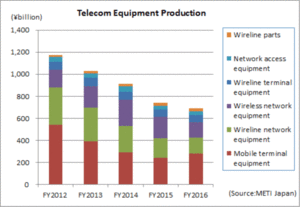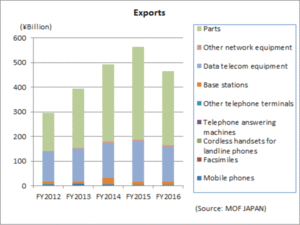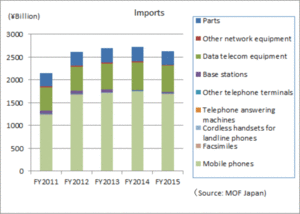The Communication and Information network Association of Japan (CIAJ) announces the telecommunication equipment and trade figures for FY2016 April through March) as follows.
The Japanese economy continued its gradual recovery in FY2016. The strong yen and slower growth among emerging markets, foremost China, led to a slower growth rate for Japan in the first half of the year, but growth in consumer spending and recovery in demand for smartphones, mainly in Asia, contributed to improveds figures for electric parts and devices in the latter half. However, enterprises reamined cautious about capital investments throughout the entire year.
Domestic production of telecommunication equipment decreased as relocation of manufacturing facilities overseas in order to meet global market demand and associated shipments. In addition, domestic mobile phone brands suffered from the end to ¥0 (carrier subsidized) mobile phones in the first half of the year, but there are positive signs as the overall Japanese economy recovers.
Due to the stronger yen in the first half, the total value of exports in FY2016 recorded negative growth for the year for the first time in four yeras in all categories. However, parts for smartphone production overseas showed signs of recovery in the latter half. Imports recorded negative growth for the first time in seven years with reluctance among businesses to make capital investments and the end to ¥0 (carrier subsidized) mobile phones, but again, there are signs of recovery in the latter half in mobile phones and data transmission equipment.
I. Domestic Production
(Based on Indices of Industrial Production compiled by the Ministry of Exonomics, Trade and Industry)
(1) FY2016 actual
The total value of production in FY2016 was 688.9 billion yen, or negative 7.0% growth over FY2015. It was the first time in five years that the negative growth was single-digit. All equipment categories, with the exception of mobile phones and applied telephone equipment recorded negative growth.
(2) Trend by categories
Actual figures by categories were as follows:
- Wireline terminal equipment
63.3 billion yen (+0.9% over FY2015). Of which telephone sets was 3.3 billion yen (-7.9% over FY2015), key telephones was 26.0 billion yen (+6.7% over FY2015), intercoms 32.7 billion yen (-1.4% over FY2015) and facsimiles 1.4 billion yen (-21.0% over FY2015). Key telephones saw an uptake in renewals, which was enough to make up for lower per unit prices. - Mobile terminal equipment
281.4 billion yen (+15.9% over FY2015). Of which mobile phones was 149.4 billion yen (-20.4% over FY2015) and public-use PHS 1.1 billion yen (-58.8% over FY2015). The shift to production of mobile phones overseas continued and the impact of the end to ¥0 (carrier subsidized) mobile phones had a negative impact, but the category as a whole grew YoY, helped by a rebound in enterprise radio equipment (such as MCA), pushing terrestrial mobile equipment up by 187.9% to 116.7 billion yen as well as the overall category into positive growth. - Wireline network equipment
144.4 billion yen (-18.4% over FY2015). Of which switching systems was 35.9 billion yen (-26.9% over FY2015) and transmission equipment 108.6 billion yen (-15.2% over FY2015). Central office switching systems saw the second consecutive drop of over 50% at 55.2% (8.8 billion yen), as public switched telephone networks (PSTN) migrated to IP networks. There was a significant decline in the transmission equipment category again, with the further shift to overseas production leading to the 46.2 billion yen, or 9.6% decline in demand for digital transmission equipment. - Wireless network equipment
138.9 billion yen (-28.8% over FY2015). Of which fixed telecommunication devices was 42.1 billion yen (-27.4% over FY2015) and base station equipment was 96.8 billion yen (-29.5% over FY2015). There was demand growth for base stations from investments in high speed 3.5GHz mobile infrastructure, but much of the growth was taken by imports, resulting in the drop in domestic production. - Network access equipment
34.3 billion yen (-5.6% over FY2015). Like wireline network equipment, the wave of domestic demand has dwindled and domestic production recorded a drop. - Wireline parts
26.6 billion yen (-1.7% over FY2015). Recovery in the latter half of the year in mobile phone production in China was not enough to push the figure into positive numbers, and ended up recording negative growth for the first time in seven years.
II. Exports
(Based on Indices of Industrial Production compiled by the Ministry of Exonomics, Trade and Industry)
(1) FY2016 actual
The total figure for exports in FY2016 was 464.3 billion yen (-17.6% year-over-year growth), recording negative growth for the first time in four years. The figure for telephone sets & terminal equipment decreased, due to the significant drop in mobile phones which has continued since FY2014. Network equipment and base stations remained flat, but all categories were affected by the stronger yen and the net performance for the year was below 2015 figures. This included parts, which was also impacted by slower growth among emerging markets and sluggish production of mobile phones, all leading to negative growth for the first time in four years. However, there are signs of mobile phone, especially smartphone demand, picking up in Asia.
(2) Trend by categories
Actual figures by category are as follows:
- Telephone sets and terminal equipment 4.2 billion yen (-21.8% over FY2015)
Of which, mobile phones was 1.5 billion yen (-37.2% over FY2015), facsimiles was 0.2 billion yen (-46.0% over FY2015), cordless handsets for landline phones was 0.2 billion yen(-15.4% over FY2015) and other was 2.3 billion yen (-3.8% over FY2015). - Network equipment 158.9 billion yen (-12.4% over FY2015)
Of which, base stations was 12.4 billion yen (-1.1% over FY2015), data communication equipment was 141.5 billion yen (-13.5% over FY2015) and other network equipment was 5.0 billion yen (-5.4% over FY2015). - Parts (both wireline and wireless) 301.1 billion yen (20.1% over FY2015).
(3) Actual figures by region
By region, Asia was 347.1 billion yen (-18.0% over FY2015), of which China was 202.0 billion yen (-29.7% over FY2015). North America was 64.7 billion yen (-19.1% over FY2015), of which the U.S. accounted for 63.5 billion yen (-19.5% over FY2015). Europe was 37.5 billion yen (-0.5% over FY2015), of which the EU was 33.7 billion yen (-0.5% over FY2015). Exports to China, which accounted for 70.5% of all exports, accounted for only 60.3% in FY2016, with the difference shifting mainly to other parts of Asia. The export of parts to Europe is also showing signs of increasing.
(4) Comparison and breakdown by regions
| First: | Asia | 74.7% (-0.4% over FY2015) |
| Second: | North America | 13.9% (-0.3% over FY2015) |
| Third: | Europe | 8.1% (+1.2% over FY2015) |
| Other regions: | 3.3% (-0.5% over FY2015) |
III. Imports
(Based on Indices of Industrial Production compiled by the Ministry of Exonomics, Trade and Industry)
(1) FY2016 actual
The total figure for exports in FY2016 was 2.632 trillion yen (-3.4% year-over-year growth), which was the first decline in seven years. Mobile phones, which makes up 64% of total imports, recorded the first decline since the category was established in FY2007, again, due in part to the impact of the end to ¥0 (carrier subsidized) mobile phones, but towards the end of the fiscal year, robust sales of new winter/spring 2017 models indicate increasing demand for upgrades in preparation for the new fiscal year. The import of base stations increased as infrastructure investments in mobile networks to accommodate 3.5 GHz high-speed communications picked up.
(2) Trend by categories
Actual figures by category are as follows:
- Telephone sets and terminal equipment 1.705 billion yen (-3.4% over FY2015)
Of which, mobile phones was 1.687 trillion yen (-3.3% over FY2015), facsimiles was 5.4 billion yen (+24.3% over FY2015), cordless handsets for landline phones was 5.2 billion yen (-13.4% over FY2015) and other was 7.0 billion yen (-19.8% over FY2015). - Network equipment 623.3 billion yen (-3.8% over FY2015)
Of which, base stations was 33.9 billion yen (+127.8% over FY2015), data communication equipment was 571.5 billion yen (-6.2% over FY2015) and other network equipment was 17.8 billion yen (-25.3% over FY2015). - Parts (both wireline and wireless) 304.0 billion yen (-2.8% over FY2015).
(3) Actual figures by region
By region, Asia was 2.481 trillion yen (-3.1% over FY2015), of which China was 2.125 trillion yen (-4.5% over FY2015). North America was 72.7 billion yen (-12.5% over FY2015), of which the U.S. accounted for 69.7 billion yen (-11.9% over FY2015). Europe was 35.7 billion yen (-7.9% over FY2015), of which the EU was 34.5 billion yen (-9.0% over FY2015).
(4) Comparison and breakdown by regions
| First: | Asia | 94.2% (+0.3% over FY2015) |
| Second: | North America | 2.8% (-0.2% over FY2015) |
| Third: | Europe | 1.4% (0.0% over FY2015) |
| Other regions: | 1.6% (0.0% over FY2015) |
IV. Trends in Orders Received and Shipped (from CIAJ statistics)
CIAJ statistics for total orders received and shipped amounted to 1.844 trillion yen (-7.4% over FY2015). The total value of domestic shipments totaled 1.473 trillion yen (-8.8% over FY2015) and exports was 371.4 billion yen (-1.1% over FY2015).
(1) Wireline terminal equipment : 348.6 billion yen (-4.1% over FY2015).
VoIP-GW shipments for telecommunication carriers exceeded the figure from FY2015, helped by the continuing migration from copper cable access traditional telephones. Multi-functioning personal facsimiles also saw significant growth as it penetrated the office-use market.
(2) Mobile terminal equipment : 594.8 billion yen (-15.9% over FY2015).
Robust sales of new winter/spring 2017 models indicating increasing demand for upgrades in preparation for the new fiscal year was seen towards the end of the fiscal year, but was not enough to offset the negative impact of the end to ¥0 (carrier subsidized) mobile phones in the first half.
(3) Wireline network equipment : 147.8 billion yen (-14.1% over FY2015).
Growth categories were other switching equipment and media converters.
(4) Wireless network equipment : 311.6 billion yen (+3.8% over FY2015).
The launch of satellites proceeding on-schedule helped bring about positive YoY growth for satellite communication equipment. Despite reluctance in overall capital investments, base stations increased as infrastructure investments in mobile networks to accommodate 3.5 GHz high-speed communications picked up and contributed to nearly flat growth for the category as a whole.
(5) Other network equipment : 39.8 billion yen (-0.1% over FY2015).
Both routers and LAN switches exceeded FY2015 figures.
(6) Parts: 30.5 billion yen (-6.5% over FY2015).
For details, contact
Market Research
CIAJ
tel: 81-3-5403-9356 fax: 81-3-5403-9360
For more general inquiries, contact
Corporate Communications
CIAJ
tel: 81-3-5403-9351 fax: 81-3-5403-9360



